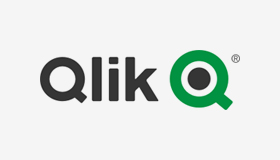Unlock a world of possibilities! Login now and discover the exclusive benefits awaiting you.
Product Innovation
By reading the Product Innovation blog, you will learn about what's new across all of the products in our growing Qlik product portfolio.
Support Updates
The Support Updates blog delivers important and useful Qlik Support information about end-of-product support, new service releases, and general support topics.
Qlik Academic Program
This blog was created for professors and students using Qlik within academia.
Community News
Hear it from your Community Managers! The Community News blog provides updates about the Qlik Community Platform and other news and important announcements.
Qlik Digest
The Qlik Digest is your essential monthly low-down of the need-to-know product updates, events, and resources from Qlik.
Qlik Learning
The Qlik Learning blog offers information about the latest updates to our courses and programs, as well as insights from the Qlik Learning team.
Recent Blog Posts
-
Quick and Easy Dashboard Makeover
This past week, with all the focus in Orlando for Qlik Connect, I decided to spend some time giving a dashboard in one of our existing demos a makeover. Given all the new capabilities that have been introduced recently, I was excited to see what I could create. Let me walk you through how I completed this dashboard makeover. -
Join Us Live! Q&A with Qlik: Qlik Open Lakehouse
November 18th at 9:00 EST / 15:00 CET -
Qlik Automate New Update
New: Concurrent runs for automations We are excited to share that Qlik Automate will now support concurrent runs, giving you more speed, scalability, and flexibility when managing your automations in Qlik Cloud. -
ValueLists, Match and Pick
A look at how I used the ValueList, Match and Pick functions to improve a visualization. -
【11/26(水)15:00 開催】金融 DX を加速!データ活用で実現する顧客体験と業務変革
デジタル変革が必須となった金融業界において、データ活用こそが競争優位性を確立する鍵です。本 Web セミナーでは、世界各国の有力金融機関が Qlik のデータ統合・分析プラットフォームを導入し、どのようにビジネスを変革したのか。以下のデータ駆動型経営の具体的な成果とその成功戦略について、深く解説します。貴社の次なる DX 戦略のヒントとして、ぜひご活用ください。 基幹システムのデータ連携を劇的に高速化し、運用コストを削減 大量のデジタルデータをリアルタイムに処理する能力を獲得し、ビジネススピードが向上 全社共通の信頼できるデータ基盤を確立し、顧客へのパーソナライズを高度化 緊急時にも迅速な意思決定と顧客サポートを可能にする体制を構築 ※ パソコン・タブレット・スマートフォンで、どこからでもご参加・ご視聴いただけます。今すぐ申し込む 今すぐ申し込む -
Qlik Sense November 2025 (Client-Managed) now available!
What’s New & What It Means for YouWe’re excited to announce the November 2025 release of Qlik Sense Enterprise on Windows. This update brings enhancements across app settings, visualizations, dashboards, and connectors making your analytics smoother, more powerful and easier to maintain. Below is a breakdown of the key features, how your teams – analytics creators, business users, data integrators and administrators – can benefit, and some practi... Show MoreWhat’s New & What It Means for You
We’re excited to announce the November 2025 release of Qlik Sense Enterprise on Windows. This update brings enhancements across app settings, visualizations, dashboards, and connectors making your analytics smoother, more powerful and easier to maintain. Below is a breakdown of the key features, how your teams – analytics creators, business users, data integrators and administrators – can benefit, and some practical next-steps to get ready. -
【11/19(水)15:00 開催】分散データをつなぎ、現場の“いま”を見える化する
外食・ホスピタリティ業界では、POS・予約・在庫・人員など多様なシステムから膨大なデータが生成される一方、それらが分断されており、即時の経営判断や顧客体験向上を阻む要因となっています。本 Web セミナーでは、「分散データの統合による現場オペレーション効率化」と「リアルタイム分析による利益最大化」という二軸から、Qlik × Talend による実践的アプローチを紹介。クラウド・オンプレ混在環境を前提に、データ統合ハブ構築からダッシュボード可視化、店舗別収益性や在庫最適化のユースケースまでを解説し、短期改善とデータドリブン経営の両立を実現する道筋を提示します。 ※ パソコン・タブレット・スマートフォンで、どこからでもご参加・ご視聴いただけます。今すぐ申し込む 今すぐ申し込む -
Qlik Cloud 10月の新機能
下記ではもう少し詳しくご紹介しています。合わせてご参照ください。 Qlik TECH TALK セミナー:What's New In Qlik ~ 2025年10月リリース最新機能のご紹介 ~ -
New Series - Qlik Sense and Salesforce Working Together
Hi guys - I'm pleased to present to you a new video series that shows you how Qlik Sense and Salesforce work together. With so many companies running multiple business systems, Qlik offers an alternative to data consolidation confusion by relating information within Salesforce and other enterprise systems for seamless visual analysis, dashboards and reports. Qlik can easily be accessed within Salesforce as a custom tab or as embedded Qlik g... Show MoreHi guys -
I'm pleased to present to you a new video series that shows you how Qlik Sense and Salesforce work together.
With so many companies running multiple business systems, Qlik offers an alternative to data consolidation confusion by relating information within Salesforce and other enterprise systems for seamless visual analysis, dashboards and reports. Qlik can easily be accessed within Salesforce as a custom tab or as embedded Qlik graphs, tables, and charts within other Salesforce tabs. Alternatively, Salesforce data can be immediately integrated into a Qlik application via a native data connector to provide an unparalleled view into your business’ entire data.
Please take a few minutes to watch and learn. Enjoy!
Regards,
Mike Tarallo
Qlik
Follow me https://twitter.com/mtarallo - for instant Qlik updates and insights!Part 1: Introduction
Part 2: Embedded Analytics Use Case Demo
Part 3: Qlik Sense Client & Other FeaturesResources:
-
今回は神回!🍁 実りの秋に学びと発見がいっぱいのQlikユーザーミートアップを開催しました!✨
秋晴れの10月28日(火)、お茶の水ソラシティにて、今年2回目となる—and 今年最後の—ユーザーミートアップを開催しました。なんと120名を超えるお申込みをいただき、会場はほぼ満席に!多くの方にご参加いただき、熱気あふれる会となりました。 今回の司会はアドボケイトの中川様にお願いし、Luminaryで幹事を務める萬様の活動報告からスタートしました。 まず、株式会社ディーエイチシー様より「Qlik Sense® オンプレ版活用事例とQlik Sense SaaS への移行」と題して、QVDやQlik NPrintingを活用した運用事例、そしてCloud移行によるQlik Automateの利用や、今後のAI活用についてご紹介いただきました。 続いて、大日本印刷株式会社様からは「購買本部の挑戦:Qlik Sense® で進める業務改革とガバナンス強化」として、従来は個別にしか得られなかった各システムの情報をつなぎ購買業務を改革した取り組みや、実際のアプリ画面をご披... Show More秋晴れの10月28日(火)、お茶の水ソラシティにて、今年2回目となる—and 今年最後の—ユーザーミートアップを開催しました。なんと120名を超えるお申込みをいただき、会場はほぼ満席に!多くの方にご参加いただき、熱気あふれる会となりました。
今回の司会はアドボケイトの中川様にお願いし、Luminaryで幹事を務める萬様の活動報告からスタートしました。
まず、株式会社ディーエイチシー様より「Qlik Sense® オンプレ版活用事例とQlik Sense SaaS への移行」と題して、QVDやQlik NPrintingを活用した運用事例、そしてCloud移行によるQlik Automateの利用や、今後のAI活用についてご紹介いただきました。
続いて、大日本印刷株式会社様からは「購買本部の挑戦:Qlik Sense® で進める業務改革とガバナンス強化」として、従来は個別にしか得られなかった各システムの情報をつなぎ購買業務を改革した取り組みや、実際のアプリ画面をご披露いただきました。
その後、第5回 Qlik データソン入賞者による受賞アプリに関するパネルディスカッションを実施。
受賞アプリの工夫や裏側について、パネラーから多くの質問が寄せられ、開発者の方々が一つひとつ丁寧に回答してくださいました。マップが思わぬ形で使われていたり、SVGで緻密にコーディングされた画像や、実はシンプルな標準機能をうまく活用した斬新なUIなどが紹介されると、会場からは思わずどよめきが。
時間いっぱいまで質問が続きましたが、午後から The AI Reality Tour Tokyo 2025 が控えていたため、皆さん今半の牛肉弁当を楽しみながらディスカッションを締めくくりました。多くの事例やアプリのテクニックが共有され、学びと発見の多い充実した会になったと思います。
ご登壇者のみなさま、お疲れさまでした!
そして、ご参加くださった皆さま、ありがとうございました!楽しんでいただけていたらうれしいです。
当日の動画もお楽しみください!
-
Multitenant Provisioning is now available!
Multitenant Provisioning is now available for our OEM Partners, Solution Provider Partners (ISVs), and Enterprise Customers with multitenant requirements. -
Qlik Cloud: Removing the deprecated Developer role and Enable API keys toggle
The following two items were deprecated in June 2025: Developer role Enable API keys toggle The deprecation notice was communicated in an Administration announcement and documented on our What's New in Qlik Cloud feed. See Developer role and API key toggle deprecated | 6/16/2025 for details. Following the deprecation, the Developer role and the Enable API keys toggle will be removed in the coming weeks, in line with the original announcement,... Show MoreThe following two items were deprecated in June 2025:
- Developer role
- Enable API keys toggle
The deprecation notice was communicated in an Administration announcement and documented on our What's New in Qlik Cloud feed. See Developer role and API key toggle deprecated | 6/16/2025 for details.
Following the deprecation, the Developer role and the Enable API keys toggle will be removed in the coming weeks, in line with the original announcement, aiming for the end of 2025.
For more information, see Qlik Cloud: Removing the deprecated Developer role and Enable API keys toggle (November 2025).
If you have any questions, we're happy to assist. Reply to this blog post or take your queries to our Support Chat.
Thank you for choosing Qlik,
Qlik Support -
Checkout the New Pivot Table!
Unlock the power of data with our new, redesigned Pivot Table available in the Visualization Bundle. -
Our most popular instructor-led courses are now available for self-paced learnin...
Our new learning paths Create Visualizations with Qlik Cloud Analytics /Qlik Sense and Data Modeling for Qlik Cloud Analytics/Qlik Sense are here! Explore the new learning Paths -
Get Ready. An Improved Certification Experience is Coming!
We are excited to continue to improve your Qlik Learning experience! The next round of improvements will change how you take certification exams. -
【開催報告】AI Reality Tour Tokyo 2025
10月28日、神田明神ホールにて AI Reality Tour Tokyo 2025を開催いたしました。その内容をご報告いたします。 -
Finance Report with Waterfall Chart
Several years ago, I wrote a blog post on how to create a profit and loss statement in QlikView. @Patric_Nordstrom has built upon this method and built a financial statement in Qlik Analytics with a straight table and waterfall chart using inline SVG. In this blog post, I will review how he did it. Here is an example of the financial statement structure. There are plain rows, such as gross sales and sales return where the a... Show MoreSeveral years ago, I wrote a blog post on how to create a profit and loss statement in QlikView. @Patric_Nordstrom has built upon this method and built a financial statement in Qlik Analytics with a straight table and waterfall chart using inline SVG. In this blog post, I will review how he did it.
Here is an example of the financial statement structure.
There are plain rows, such as gross sales and sales return where the amount is the sum of the transactions made against the accounts. There are subtotals such as net sales and gross margin which are a sum of the previous plain rows. And there are also partial sums such as total cost of sales that is a sum of a subset of the previous plain rows, but not all the previous plain rows.
Patric identified two functions, RangeSum() and Above() that are suitable for calculating the subtotal and partial sums in a table. The RangeSum function sums a range of values, and the Above function evaluates an expression at a row above the current row within a column segment in a table. The above function can be used with 2 optional parameters – offset and count to further identify the rows to be used in the expression.
The layout table below is used as a template for the financial statement.
- The RowStyle column is used for styling the rows making text bold or underlining it. Currently, we cannot use tab or blank tags but hopefully in the future this will become available in the straight table.
- The RowTitle is the account category that is to be used in the financial statement.
- RowType is used to as input to calculate the offset and count for the above function.
- AC is the actual amount.
The AC column is included here in the layout file for demo purposes but could be calculated from the accounts and transactions in the data model as well.
In the script, the layout table was loaded, and additional fields were created to support the waterfall chart, specifically offset and count fields to be used with the above function.
Here is a view of the layout table with the new fields that were created in the script.
After the layout table is loaded and the new fields are created, some master measures can be created to be used in the inline SVG expression. Here are the 3 master measures Patric created:
mBar is the bar length with an offset that is always 0.
mStart is the starting position of the bar in the waterfall chart and for subtotals, this is always 0.
mMax is the max bar length which is used to scale the bars in the waterfall chart.Now the straight table can be created. The RowNr field is added for sorting purposes. The RowTitle field and the AC fields are added to show the account groupings in the financial statement along with their value. The below inline SVG expression for the waterfall chart is the last column added to the straight table. It is made up of 3 parts:
- A plain line with an offset
- A thin gray line where x=0
- A label
- The if statement on line 1 will determine if a bar is displayed. Bars will only be visible if the RowStyle is not blank.
- Line 2 has the viewBox settings and sets the 0 for the x-axis.
- On line 3 is the light gray line where x=0 and it is displayed on all non-blank rows of the financial statement.
- Lines 4 and 5 in the yellow box is the plain line with the offset, scaled using the mMax measure to control the length of the line.
- Line 6 handles the bar color, light green for positive values and red for negative values.
- On line 7, the if statement is used to set the stroke width of the bar. A thin line is used if the RowType is retrosum and a wider line is used for all other bars.
- In the red box, on lines 10 through 13, the label text is set and placed either to the left or right of the bar depending on the value. Positive values are placed to the right of the bar and negative values are placed to the left of the bar.
The result of the financial statement looks like this:
To add the text styling (bold and underline) from the layout table, the RowStyle field was added to the text style expression in the RowTitle and AC columns.
Indentation is added by using the repeat function in the RowTitle column. It will repeat a non-breaking space 6 times if there is a tab tag in the RowStyle field. Otherwise, no indentation is done.
If the RowStyle is not blank, a bar is displayed for the waterfall chart and the sum value for the actual amount (or mBar) in this case is displayed.
The chart column representation is set to Image in the properties of the straight table.
While this method looks complex, it is a simple and clean solution for adding a waterfall chart to a financial statement using straight table features and inline SVG. Using the layout table and inline SVG provides room for customization so that the financial report meets the needs and requirements of the user or customer.
Thanks,
Jennell
-
Techspert Talks - Build on Iceberg with Qlik Open Lakehouse
Hi everyone, Want to stay a step ahead of important Qlik support issues? Then sign up for our monthly webinar series where you can get first-hand insights from Qlik experts. The session from November looked at Building on Iceberg with Qlik Open Lakehouse. But wait, what is it exactly?Techspert Talks is a free webinar held on a monthly basis, where you can hear directly from Qlik Techsperts on topics that are relevant to Customers and Partners t... Show MoreHi everyone,
Want to stay a step ahead of important Qlik support issues? Then sign up for our monthly webinar series where you can get first-hand insights from Qlik experts.The session from November looked at Building on Iceberg with Qlik Open Lakehouse.
But wait, what is it exactly?
Techspert Talks is a free webinar held on a monthly basis, where you can hear directly from Qlik Techsperts on topics that are relevant to Customers and Partners today.In this session we will cover:
- Benefits of Iceberg Lakehouse
- How to build an Open Lakehouse
- Mirroring
-
Qlik Replicate and an update on Salesforce “Use Any API Client” Permission Depre...
Dear Qlik Replicate customers, Salesforce announced (October 31st, 2025) that it is postponing the deprecation of the Use Any API Client user permission. See Deprecating "Use Any API Client" User Permission for details. Qlik will keep the OAUT plans on the roadmap to deliver them in time with Salesforce's updated plans. Salesforce has announced the deprecation of the Use Any API Client user permission. For details, see Deprecating "Use Any API ... Show MoreDear Qlik Replicate customers,
Salesforce announced (October 31st, 2025) that it is postponing the deprecation of the Use Any API Client user permission. See Deprecating "Use Any API Client" User Permission for details.
Qlik will keep the OAUT plans on the roadmap to deliver them in time with Salesforce's updated plans.
Salesforce has announced the deprecation of the Use Any API Client user permission. For details, see Deprecating "Use Any API Client" User Permission | help.salesforce.com.
We understand that this is a security-related change, and Qlik is actively addressing it by developing Qlik Replicate support for OAuth Authentication. This work is a top priority for our team at present.
If you are affected by this change and have activated access policies relying on this permission, we recommend reaching out to Salesforce to request an extension. We are aware that some customers have successfully obtained an additional month of access.
By the end of this extension period, we expect to have an alternative solution in place using OAuth.
Customers using the Qlik Replicate tool to read data from the Salesforce source should be aware of this change.Thank you for your understanding and cooperation as we work to ensure a smooth transition.
If you have any questions, we're happy to assist. Reply to this blog post or take your queries to our Support Chat.Thank you for choosing Qlik,
Qlik Support -
Qlik and Talend Subprocessors - Version 6.7 - 28th October 2025
Version 6.7 Current as of: 28th October 2025 Qlik and Talend, a Qlik company, may from time to time use the following Qlik and Talend group companies and/or third parties (collectively, “Subprocessors”) to process personal data on customers’ behalf (“Customer Personal Data”) for purposes of providing Qlik and/or Talend Cloud, Support Services and/or Consulting Services. Qlik and Talend have relevant data transfer agreements in place with the Subp... Show MoreVersion 6.7 Current as of: 28th October 2025
Qlik and Talend, a Qlik company, may from time to time use the following Qlik and Talend group companies and/or third parties (collectively, “Subprocessors”) to process personal data on customers’ behalf (“Customer Personal Data”) for purposes of providing Qlik and/or Talend Cloud, Support Services and/or Consulting Services.
Qlik and Talend have relevant data transfer agreements in place with the Subprocessors (including group companies) to enable the lawful and secure transfer of Customer Personal Data.
You can receive updates to this Subprocessor list by subscribing to this blog or by enabling RSS feed notifications.
Third party subprocessors for Qlik Cloud
Third Party
Location of processing (e.g., tenant location)
Service Provided/Details of processing
Address of contracting party
Contact
Amazon Web Services
(AWS)
If EMEA region is chosen:
Ireland (Republic of); &
Spain (back-up); or
Frankfurt, Germany; &
Milan, Italy (back-up); or
London, UK; &
Spain (back-up);
or
UAE (back-up also in UAE); or
Israel (back-up also in Israel).
Qlik Anonymous Access:
Stockholm,
Sweden.
If AMER region is chosen:
North Virginia, US; &
Ohio, US (back-up) or
Brazil (back-up also in Brazil).
If APAC region is chosen:
Sydney, Australia; &
Melbourne, Australia (back-up); or
Singapore;&
Seoul, S. Korea(back-up); or
Tokyo, Japan;&
Osaka, Japan(back-up); or
Mumbai, India;
Hyderabad, India (back-up).
Qlik Cloud is hosted through AWS
Amazon Web Services, Inc. 410 Terry Avenue North, Seattle, WA 98109-5210, U.S.A
MongoDB
See Qlik Cloud locations above Any data inputted into the Notes feature in Qlik Cloud
Mongo DB, Inc.
229 West 43rd St.,
New York, NY 10036
USAThird party subprocessors for Qlik mobile device apps
Google Firebase
United States
Push notifications
Google LLC
1600 Amphitheatre Parkway
Mountain View
California
United StatesThird party subprocessors for Talend Cloud
Third Party
Location of processing (e.g., tenant location)
Service Provided/Details of Processing
Address of contracting party
Contact
Amazon Web Services (AWS)
Talend Cloud
AMERICAS:
Virginia, US; &
Oregon, US (backup).
EMEA:
Frankfurt, Germany; &
Ireland (Republic of)(backup).
APAC:
Tokyo, Japan; &
Singapore (backup); or
Sydney, Australia; &
Singapore (backup); or
Singapore;&
Seoul, S. Korea(back-up);
Stitch
AMERICAS:
Virginia, US; &
Oregon, US (backup).
EMEA:
Frankfurt, Germany; &
Ireland (Republic of) (backup).
These Talend Cloud locations are hosted through AWS
Amazon Web Services, Inc.
410 Terry Avenue North, Seattle, WA 98109-5210, U.S.A.Microsoft Azure
United States:
California; Virginia (backup)These Talend Cloud locations are hosted through Microsoft Azure
Microsoft Corporation
1 Microsoft Way, Redmond, WA 98052, USAMicrosoft Enterprise Service Privacy
Microsoft Corporation
1 Microsoft Way
Redmond, Washington 98052 USAMongoDB
See Talend Cloud locations above Mongo DB, Inc.
229 West 43rd St.,
New York, NY 10036
USAThird party subprocessors for Qlik and Talend Support Services and/or Consulting Services
The vast majority of Qlik’s support data that it processes on behalf of customers is stored in Germany (AWS). However, in order to resolve and facilitate the support case, such support data may also temporarily reside on the other systems/tools below.
Third Party
Location of processing (e.g., tenant location)
Service Provided/Details of processing
Address of contracting party
Contact
Amazon Web Services
(AWS)
Germany
Support case management tools
Amazon Web Services, Inc.
410 Terry Avenue North, Seattle, WA 98109-5210, U.S.A.
Salesforce
UK
Support case management tools
Salesforce UK Limited
Village 9
Floor 26 Salesforce Tower
110 Bishopsgate
London, UK
EC2N 4AYMicrosoft
United States
Customer may send data through Office 365
Microsoft Corporation
One Microsoft Way,
Redmond, WA
98052
USAChief Privacy Officer
One Microsoft Way,
Redmond, WA
98052
USAAda
Germany
Support Chatbot
Ada Support
371 Front St W,
Unit 314
Toronto, Ontario
M5V 3S8
CANADAPersistent
India
R&D Support Services
2055 Laurelwood Road
Suite 201
Santa Clara, California 95054
USAAtlassian
(Jira Cloud)
Germany, Ireland (Back-up)
R&D support management tool
350 Bush Street
Floor 13
San Francisco, CA 94104
United StatesStretch Qonnect APs
Denmark
2nd line support for the Qlik Analytics Migration Tool
Kompagnistræde 21
1208 Copenhagen
Denmark
Affiliate Subprocessors for Qlik and Talend
Affiliate Subprocessors
These affiliates may provide services, such as Consulting or Support, depending on your location and agreement(s) with us. Our Support Services are predominantly performed in the customer’s region:
EMEA – France, Sweden, Spain, Israel; Americas – USA; APAC – Japan, Australia, India.
Subsidiary Affiliate
Location of processing (e.g., tenant location)
Service Provided/Details of Processing
Address of contracting party
Contact
QlikTech International AB
Sweden
These affiliates may provide services, such as Consulting or Support, depending on your location and agreement(s) with us. Our Support Services are predominantly performed in the customer’s region: EMEA – France, Sweden, Spain, Israel; Americas – USA; APAC – Japan, Australia, India.
Scheelevägen 26
223 63 Lund
Sweden
QlikTech Nordic AB
Sweden
QlikTech Latam AB
Sweden
QlikTech Denmark ApS
Denmark
Dampfaergevej 27-29, 5th Floor 2100 København Ø Denmark
QlikTech Finland OY
Finland
Simonkatu 6 B 5th Floor FI-00100 Helsingfors Finland
QlikTech France SARL, Talend SAS
France
93 Ave Charles de Gaulle 92200 Neuilly Sur Seine France
QlikTech Iberica SL (Spain)
Spain
"Blue Building", 3rd Floor Avinguda Litoral nº 12-14 08005 Barcelona Spain
QlikTech Iberica SL (Portugal liaison office), Talend Sucursal Em Portugal
Portugal
QlikTech GmbH
Germany
Joseph-Wild-Str. 23 81829 München Germany
QlikTech GmbH (Austria branch)
Austria
Am Euro Platz 2, Gebäude G A-1120, Wien, Austria
QlikTech GmbH (Swiss branch)
Switzerland
c/o Küchler Treuhand
Brünigstrasse 25, CH-6055 Alpnach Dorf
Switzerland
QlikTech Italy S.r.l.
Italy
Piazzale Luigi Cadorna 4 20123 Milano (MI)
QlikTech Netherlands BV
Netherlands
Evert van de Beekstraat 1-122
Building B, 6th Floor
1118 CL SchipholQlikTech Netherlands BV (Belgian branch)
Belgium
Culliganlaan 2D
1831 DiegemBlendr NV
Belgium
Bellevue Tower Bellevue 5, 4th Floor, Ledeberg 9050 Ghent Belgium
QlikTech UK Limited
United Kingdom
1020 Eskdale Road, Winnersh, Wokingham, RG41 5TS United Kingdom
Qlik Analytics (ISR) Ltd.
Israel
1 Atir Yeda St, Building 2 7th floor 4464301, Kfar Saba Israel
QlikTech International Markets AB (DMCC Branch)
United Arab Emirates
AB (DMCC Branch)
JBC 3 Building, Cluster Y
3rd Floor, Office 301
P.O. Box 120115
Jumeirah Lake Towers DubaiQlikTech Inc.
United States
211 South Gulph Road Suite 500 King of Prussia, Pennsylvania 19406
QlikTech Corporation (Canada)
Canada
1133 Melville Street Suite 3500, The Stack Vancouver, BC V6E 4E5 Canada
QlikTech México S. de R.L. de C.V.
Mexico
c/o IT&CS International Tax and Consulting Service San Borja 1208 Int. 8 Col. Narvate Poniente, Alc Benito Juarez 03020 Ciudad de Mexico Mexico
QlikTech Brasil Comercialização de Software Ltda.
Brazil
51 – 2o andar - conjunto 201 Vila Olímpia – São Paulo – SP Brazil
QlikTech Japan K.K.
Japan
105-0001 Tokyo Toranomon Global Square 13F, 1-3-1. Toranomon, Minato-ku, Tokyo, Japan
QlikTech Singapore Pte. Ltd.
Singapore
9 Temasek Boulevard Suntec Tower Two Unit 27-01/03 Singapore 038989
QlikTech Hong Kong Limited
Hong Kong
Unit 19 E Neich Tower 128 Glouchester Road Wanchai, Hong Kong
Qlik Technology (Beijing) Limited Liability Company, Talend China Beijing Technology Co. Ltd.
China
51-52, 26F, Fortune Financial Center, No. 5 Dongsan Huanzhong Road, Chaoyang district, Pekin / Beijing, 100020 China
QlikTech India Private Limited, Talend Data Integration Services Private Limited
India
“Kalyani Solitaire” Ground Floor & First Floor 165/2 Krishna Raju Layout Doraisanipalya Off Bannerghatta Road, JP Nagar, Bangalore 560076
QlikTech Australia Pty Ltd
Australia
McBurney & Partners Level 10 68 Pitt Street Sydney NSW 2000 Australia
QlikTech New Zealand Limited
New Zealand
Kensington Swan 40 Bowen Street Wellington 6011 New Zealand
In addition to the above, other professional service providers may be engaged to provide you with professional services related to the implementation of your particular Qlik and/or Talend offerings; please contact your Qlik account manager or refer to your SOW on whether these apply to your engagement.
Qlik and Talend reserve the right to amend its products and services from time to time. For more information, please see www.qlik.com/us/trust/privacy and/or https://www.talend.com/privacy/.















































